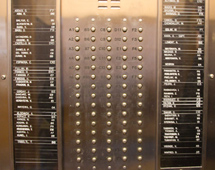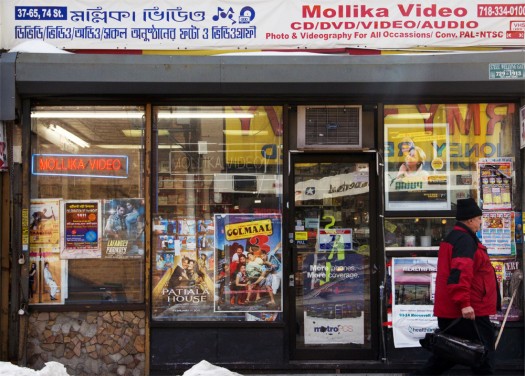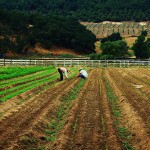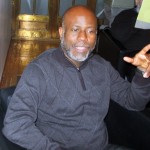Urban Omnibus, an online publication of the Architectural League of New York recently posted an interview with the author Suketu Mehta that we found fascinating. We’ve posted an excerpt below, you can go to Urban Omnibus for the whole story.
Suketu Mehta is a writer who has dedicated his career to understanding the human experience of large cities around the world. He is perhaps best known for his exploration of Mumbai, the city where he spent his childhood, in Maximum City: Bombay Lost and Found. These days his writing is mostly focused on immigrants in New York, the city where he moved as a teenager in the late 1970s. He is currently working on a nonfiction book about immigrants in contemporary New York, for which he was awarded a 2007 Guggenheim fellowship. Urban Omnibus‘ Cassim Shepard recently took a walk with him through Jackson Heights, Queens, and interviewed him about immigration, density and neighborhood change.
When did you first encounter Jackson Heights?
I first came here in 1977, at the age of fourteen. My father has been a diamond merchant for all of his life, and he came to New York to expand the family business. He had already been here, in a studio apartment on 73rd Street on the other side of Roosevelt Avenue, for about nine months. Then he went back to India and brought the rest of the family. So there were five of us in a studio. Our welcome to America was the super of the building turning off our electricity because there were too many people in the apartment. We were only in that studio for a couple of weeks before we got an apartment on 83rd Street, where we lived for another seven years. On the first night that we moved in, my brand new bike got stolen. It was a much dodgier neighborhood back then.
How else would you describe the neighborhood at that time?
When we came here, we found a dangerous city, a bankrupt city, a city from which the white middle class was fleeing. It was far from the Promised Land. I got mugged twice in these streets; our car got stolen regularly. Jackson Heights was not glamorous or welcoming. My parents put me in Catholic School near here, which was the most brutal experience of my life. I was one of the first minorities in the school. The teachers called me a pagan. I remember during the Iranian hostage crisis, I was a senior in high school, I was with an Indian friend of mine — the only other Indian in school — and this Irish kid yells at us, “Fucking Ayatollahs!” and I said, “Hey, we ain’t Iranians, we’re Indians.” And without missing a beat he says, “Fucking Gandhis!”
At the time that we came here, most of the South Asians in this neighborhood were Indians, and most of them Gujarati. Now, it’s a much more diverse mix of South Asians: Bangladeshis, Nepalis, Tibetans, Bhutanese. The Indians started coming here in large numbers after the 1965 Immigration Act. Before ’65, Asians were actively excluded. When they started letting in Indians, at first, there were a lot of professionals: engineers, doctors. In the ’70s, because of the Family Reunification Act, entrepreneurs, small business owners, shop owners, they started coming in. And now, taxi drivers, garment factory workers, laborers — it’s constantly shifting. Very few of the Gujaratis that I knew when I was growing up here in the ’70s are still in this neighborhood. With one exception: Some of the children of those families, many friends of mine, who are artists, writers and journalists, who would live in the East Village in the ’80s and in Park Slope in the late ’90s, are increasingly moving to Jackson Heights.
There’s something about the diversity of these streets that is attractive to people from all over, like a piano player or a software engineer raised in Kansas, for example. Increasingly, creative people will want to live in the kind of city where they have a choice between pupusas and parathas. Diversity isn’t just a nice thing to have, it is actively essential to attract the kind of people that create wealth.
[…]
Name plate in the building where Suketu Mehta grew up in Jackson Heights, Queens. (Photo via Urban Omnibus)
Now here’s the building I grew up in. Look at the name plate: we have from Abbasi to Winfred, passing Balyuk, Bruschtein, Basu… For anyone going to Jackson Heights, I recommend having a look at the directories in the buildings, which really show why it is such a marvelous area. Here are people – Indians and Pakistanis, Bangladeshis, Russians, Greeks, Poles, Turks, Irish – many of whom were killing each other just before they got on the plane. And here they are living next to each other. It’s not that we love each other. Indians and Pakistanis will still say horrible things about each other around the dinner table. But there was this agreement that we were in a new country, making a new life. And we could live side by side and interact in certain demarcated ways. We could exchange food; our kids could play together; they could go to school together. It’s the great story of New York. It’s pretty remarkable how little strife there is.
This kind of density, living in the same space, having to share courtyards and groceries, forces you to interact more than you otherwise would. It forces you to go outside of your comfort zone. The most wonderful thing about Jackson Heights is its diversity. Jackson Heights and Elmhurst together are the most diverse neighborhoods in New York City in terms of country of origin. I think that’s the biggest difference between immigrants of today and immigrants of maybe one hundred years ago. These immigrants feel much less inclined to melt into any sort of pot.
For the rest of the story, go to Urban Omnibus, an online publication of the Architectural League of New York.





